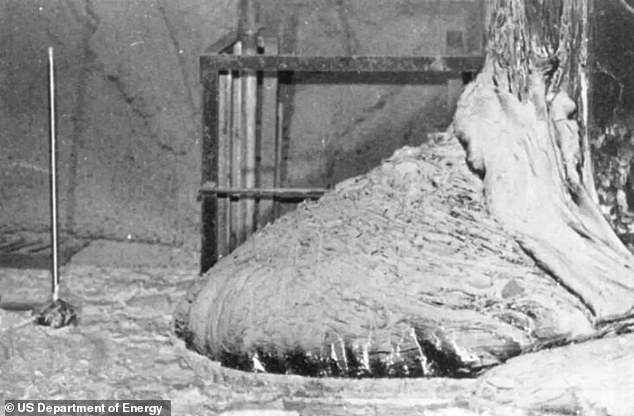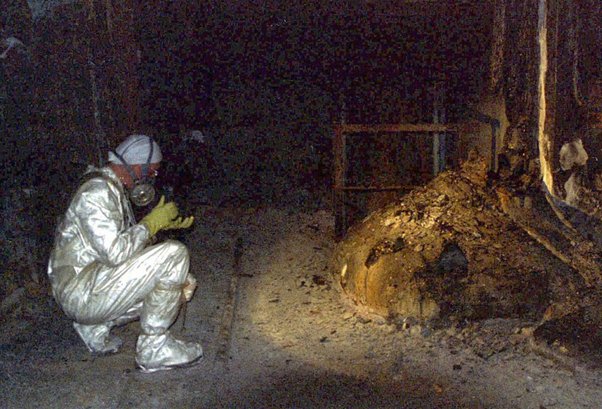Terrified by the most “dangerous” thing in the world: Just looking at it for 5 minutes can kill you, and you won’t be able to get close for hundreds of years
This object, shaped like a giant leg, is located in the Chernobyl area, Ukraine.
At first glance, you might mistake this for a supernatural object, taken from a science fiction story. However, it is completely real, the result of one of the most terrifying radiation leaks in history. To this day, people still call this object “The Elephant’s Foot”.
The Daily Mail calls the “Elephant’s Foot” “the most dangerous thing in the world.” Even looking at it can be fatal. Scientists predict that even hundreds of years from now, we won’t be able to get close to the “Elephant’s Foot” without protective gear.

Image of an object known as the “Elephant’s Foot”
How did the “elephant foot” appear?
On April 26, 1986, reactor number 4 of the Chernobyl nuclear power plant in Ukraine experienced an accident. Experts discovered the problem and attempted an emergency shutdown, but were unsuccessful. The temperature in the reactor core rose to an uncontrollable level, causing the cooling water to immediately evaporate when pumped in.
The reactor eventually exploded due to excessive pressure, causing the Chernobyl nuclear disaster. That fall, as rescue teams arrived to contain the radiation, they first discovered the “world’s most dangerous object.”
According to scientists, reactor No. 4, when heated, melted the steel and concrete surrounding it, creating “radioactive lava”. This object flowed down, swept over many other objects, becoming a complex mixture with extremely high concentrations of radiation. When it cooled, this solidified into a new material called corium. It was named “Elephant’s Foot”.

An expert approaches the “Elephant’s Foot”
The Danger of the “Elephant’s Foot”
In 1986, the Elephant’s Foot emitted 10,000 x-rays (a unit of radiation) per hour – a dose 1,000 times higher than the level that can cause cancer. To put that in perspective, that amount of radiation is equivalent to 4.5 million x-rays that humans use during X-rays.
If you come into contact with this substance for 30 seconds, you will feel dizzy and tired for at least a week. If you come into contact for 2 minutes, the cells will start to bleed. After 4 minutes, it will cause vomiting, diarrhea and fever. Finally, after 5 minutes of being near it, the person exposed is almost beyond help, dying within 2 days.
Because of the danger of the “Elephant’s Foot”, there are very few photographs of this object. The first photo was taken in 1986 by members of a rescue team. Ten years later, the US Department of Energy also collected some photos of it.

Due to the large radiation, the recorded image of the “Elephant’s Foot” was also affected.
However, the person who had the most contact with the elephant’s foot was Artur Korneyev, deputy director of the Shelter Object project. He also took several photos of the “Elephant’s Foot” before safely stepping out. An article published in 2021 revealed that Artur was still alive, in Ukraine.
However, Mr. Artur is an experienced expert, wearing strict protective gear when coming into contact. Scientists still warn about the danger of the “Elephant’s Foot” despite the object gradually cooling after 4 decades.
In 2016, a concrete and steel structure called the “Safe Prison” was placed above the “Elephant’s Foot” to limit the leakage of radiation to the outside. Since corium is very rare, having only appeared 5 times in history, no one is sure how the “Elephant’s Foot” will change in the future.
News
Top 10 Most Beautiful Indian Actress in 2024 | Only Top10
Top 10 Most Beautiful Indian Actress in 2024 | Only Top10 Bollywood Actress: The Bollywood film industry holds a prominent position in Indian cinema, known for its grandeur and captivating storytelling. With their remarkable performances and exceptional acting prowess, numerous…
Who Is The Most Popular Bollywood Actress 2024?
Who Is The Most Popular Bollywood Actress 2024? Bollywood has always been home to some of the most talented and iconic actresses who have defined and redefined Indian cinema over the years. As we step into 2024, the competition is…
Reality of Malaika Arora and Arjun Kapoor’s div0®ce / Has Malaika Arora found a new boyfriend?
Reality of Malaika Arora and Arjun Kapoor’s div0®ce / Has Malaika Arora found a new boyfriend? Malaika Arora teases her relationship status for first time after Arjun Kapoor confirmed he is single Malaika Arora and Arjun Kapoor started dating in…
Alia being SHADY towards Sara? | Genelia takes a dig at Sonam Kapoor?
Alia being SHADY towards Sara? | Genelia takes a dig at Sonam Kapoor? Genelia Deshmukh’s Comment From A Clip Goes Viral Where Sonam Kapoor Was Called ‘Jealous’ Of Her Genelia Deshmukh dropped a comment on a reel that called out…
Shah Rukh Khan is the ULTIMATE role model: Life Lessons for Kids from the Bollywood Superstar
Shah Rukh Khan is the ULTIMATE role model: Life Lessons for Kids from the Bollywood Superstar Shah Rukh Khan, often called the King of Bollywood, is not only known for his exceptional acting but also for the life lessons he…
2nd time pregnant Alia Bhatt hide her baby bump at Raj Kapoor 100 anniversary celebration
2nd time pregnant Alia Bhatt hide her baby bump at Raj Kapoor 100 anniversary celebration Alia Bhatt, Sonam Kapoor THESE top B-town celebs moms whose maternity style is on point Here a list of Bollywood actress who has up their…
End of content
No more pages to load











